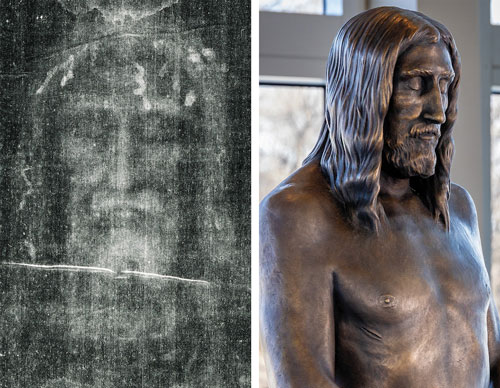Image

The Raised Man of the Shroud
An interview with Dr. Gilbert Lavoie on what he discovered about the renowned Shroud of Turin
 From left: A photographic negative reveals the faint image on the Shroud of Turin in more distinctive detail — a discovery made in 1898. (Photo by Vernon Miller (© 1978), courtesy of Dr. Gilbert Lavoie) • A bronze sculpture titled “The Sign” is pictured at the Saint John Paul II National Shrine in Washington, D.C., as it hosts a temporary exhibit on the Shroud of Turin. The sculpture was created by artist Pablo Eduardo in 2022 in collaboration with Dr. Gilbert Lavoie. (Photo by George Goss, courtesy of Dr. Gilbert Lavoie)
From left: A photographic negative reveals the faint image on the Shroud of Turin in more distinctive detail — a discovery made in 1898. (Photo by Vernon Miller (© 1978), courtesy of Dr. Gilbert Lavoie) • A bronze sculpture titled “The Sign” is pictured at the Saint John Paul II National Shrine in Washington, D.C., as it hosts a temporary exhibit on the Shroud of Turin. The sculpture was created by artist Pablo Eduardo in 2022 in collaboration with Dr. Gilbert Lavoie. (Photo by George Goss, courtesy of Dr. Gilbert Lavoie)A mysterious linen cloth, approximately 14 feet by 3.5 feet, bearing the front-and-back image of a scourged and crucified man, has been an object of veneration and debate for centuries. The first documented appearance of the Shroud of Turin, as it would come to be known, took place in a small village in northern France in 1353. While many people came to embrace it as the burial shroud of Jesus, others, including some bishops, sought to debunk it as a clever forgery.
This debate became a global phenomenon after the shroud was photographed by Secondo Pia in 1898 at the Cathedral of Turin, Italy. What Pia saw on the reverse plate in the darkroom shocked him: a positive image of details of the man’s body and face that could not be seen by the naked eye. What the naked eye sees is actually a photographic negative. This astonishing discovery made headlines around the world and led to a series of scientific studies of the shroud in multiple disciplines, from chemistry and biology to medical forensics and image analysis — studies that continue today, making it the single-most studied artifact in history.
The Catholic Church has never taken an official stance on the shroud’s authenticity and refrains from calling it a relic. When visiting the Cathedral of Turin in 1998 on the 100th anniversary of Pia’s first photograph, St. John Paul II explained, “Since it is not a matter of faith, the Church has no specific competence to pronounce on these questions. She entrusts to scientists the task of continuing to investigate… [and] invites them to act with interior freedom and attentive respect for both scientific methodology and the sensibilities of believers.”
One such researcher is Dr. Gilbert Lavoie, FINISH READING HERE